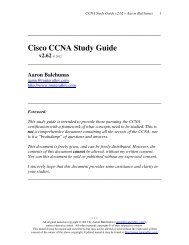OSI Reference Model - Router Alley
OSI Reference Model - Router Alley
OSI Reference Model - Router Alley
You also want an ePaper? Increase the reach of your titles
YUMPU automatically turns print PDFs into web optimized ePapers that Google loves.
<strong>OSI</strong> <strong>Reference</strong> <strong>Model</strong> v1.31 – Aaron Balchunas<br />
10<br />
<strong>OSI</strong> <strong>Reference</strong> <strong>Model</strong> Example<br />
A web browser serves as a good practical illustration of the <strong>OSI</strong> model and<br />
the TCP/IP protocol suite:<br />
• Τhe web browser serves as the user interface for accessing a website. The<br />
browser itself does not function at the Application layer. Instead, the<br />
web browser invokes the Hyper Text Transfer Protocol (HTTP) to<br />
interface with the remote web server, which is why http:// precedes every<br />
web address.<br />
• The Internet can provide data in a wide variety of formats, a function of<br />
the Presentation layer. Common formats on the Internet include HTML,<br />
XML, PHP, GIF, and JPEG. Any encryption or compression mechanisms<br />
used on a website are also considered a Presentation layer function.<br />
• The Session layer is responsible for establishing, maintaining, and<br />
terminating the session between devices, and determining whether the<br />
communication is half-duplex or full-duplex. However, the TCP/IP stack<br />
generally does not include session-layer protocols, and is reliant on<br />
lower-layer protocols to perform these functions.<br />
• HTTP utilizes the TCP Transport layer protocol to ensure the reliable<br />
delivery of data. TCP establishes and maintains a connection from the<br />
client to the web server, and packages the higher-layer data into<br />
segments. A sequence number is assigned to each segment so that data<br />
can be reassembled upon arrival.<br />
• The best path to route the data between the client and the web server is<br />
determined by IP, a Network layer protocol. IP is also responsible for<br />
the assigned logical addresses on the client and server, and for<br />
encapsulating segments into packets.<br />
• Data cannot be sent directly to a logical address. As packets travel from<br />
network to network, IP addresses are translated to hardware addresses,<br />
which are a function of the Data-Link layer. The packets are<br />
encapsulated into frames to be placed onto the physical medium.<br />
• The data is finally transferred onto the network medium at the Physical<br />
layer, in the form of raw bits. Signaling and encoding mechanisms are<br />
defined at this layer, as is the hardware that forms the physical<br />
connection between the client and the web server.<br />
* * *<br />
All original material copyright © 2012 by Aaron Balchunas (aaron@routeralley.com),<br />
unless otherwise noted. All other material copyright © of their respective owners.<br />
This material may be copied and used freely, but may not be altered or sold without the expressed written<br />
consent of the owner of the above copyright. Updated material may be found at http://www.routeralley.com.

















